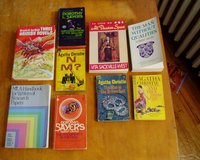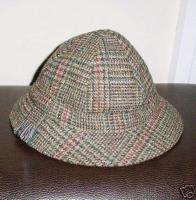Opera is exciting to many people for many reasons - you've got voices and music and theater staging and acting and choreography and a story that's already been told and retold a few times . . .
But Alex Ross takes it bit far, in his article "Countdown" on John Adams and Peter Sellars' "Doctor Atomic." Or he doesn't take it far enough. He tries to cover everything in the ol' Gesamtkunstwerk without structuring his thoughts, and if I were him, I'd structure them around a critical point, or perhaps the questions, "Just what kind of representation is this - is it realist in any sense, an allegory, a historical record, what? What kind of representation does it want to be? And why?"
Sellars and Adams are conflicted, and surely this must tell in the opera, about what kind of representation they are creating. No, they don't have to settle on one, that isn't quite the formal or historical nature of opera, is it? But the conflicted work that arises is bound to the conflicts they articulate . . . Ross doesn't make that clear. What follows is a scattered account of the scattered accounts given by Sellars, Adams and Ross . . .
***
Sellars: "This is 'Goetterdaemmerung' for our generation, with our speed, with our tension points, with our nervous energy, but with nothing being a metaphor and everything being a reality." (62)
Well, I'm all hot for non-metaphoric thought. So the work of art is going bear an experiential or sensational relationship to a period, but not a metaphoric or allegorical one, as we might now understand Goetterdaemmerung to have done in its time. That sounds great . . . but . . .
Ross follows this quote with an exploration of the historical reading the creators and cast have done and Sellars' relationship to the libretto "assembled from extant material," not written as fiction. Ross emphasizes that "Events are sometimes condensed but almost every line can be checked against a source." So what? What is the significance of a historically accurate representation? Why depend on this kind of documentary truth? And how does documentary meet sensation? Without becoming allegorical?
Adams; For Adams, maybe it doesn't. A telling quote from him mixes them all up together and adds an element of what he calls elsewhere "the psychic" :
" 'The atomic bomb was the ultimate archetype [abstracted, metaphoric figure], the ultimate looming presence [of fear, a psychic experience]. And I do remember, as a kid - I don't know how old I was, maybe seven or eight years old - living in the most secure, Steven Spielbergesque, idyllic village in New Hampshire [postmodern refraction of experience through pop media] . . . getting into bed one night, and my mother gave me a kiss and turned out the light [sexual and psychic]. I heard a jet plane way, way high up in the sky, [sensory] and I went into a panic, because I wondered if that was the Russians [historical context] coming to bomb us.' " (64)
I think this is the longest quote Ross uses from Adams. Although it unites a particularly obvious Oedipal psychic scene with a precise sense experience, in a historical time, it actually distances Adams' experience from that of the figures in the opera, or the historical moment. His experience seems naive and melodramatic compared to the experience of Oppenheimer and the others he is trying to represent.
Sellars: When Ross gets to Sellars and the actors, its all about psychology and how these various characters might really feel. So the representation is psychological realism of some kind? (And a psychological realism that Ross actually identifies with, using the personal pronoun "I" )
The best passage of the piece mentions Sellars' undergrad work which, Ross suggests, tried to reconcile "avant garde theater of abstraction and defamiliarization" (Brecht, Beckett, Artaud, etc) with "Stanislavsky's art of psychological naturalism" (ie, Hollywood cinema from Brando to DeNiro) - a huge historical and theoretical tension in 20th C US performance. In this quick reference, there is some suggestion of how this tension over the ways and means of representation might influence "Doctor Atomic," but Ross avoids going there with a lame from Andrew Porter, which says simply that Sellars' work is " 'meant for nimble minds' " Why nimble, how nimble? Because there is no single consistant, identifiable representaional strategy. Why not say it and explore it?
Sellars: According to Ross, Sellars gives the orchestra musicians "the same sort of Stanslavskian motivation that he had offered to the singers" - he offers them fairly specific meanings to attach to the sounds they are making. This is a very representational representational strategy, which Sellars himself contrasts with understanding music as "purely descriptive."
Adams: Ross offers plenty of his own, very formal descriptions of the movement of the music. These are fine of course, but sometimes Ross gets carried away with being descriptive without telling us how the music fits with or works against other elements of the opera - ie, the narrative, the actors, the language, the voice. He suggests that the music works against itself, as it references "the entire ghoulish army of twentieth century styles." (69)
With, of course, a signficant "archaic gesture" thrown in. Just more evidence that this opera is all over the place for all kinds of reasons, none of which Ross really tries to get to the heart of. Frankly, this is the moment that maybe frustrates me most - Adams music is often spare, minimalist, repetitive, tight. A kind of closed and measured system. Here, obviously the music is wild, and its interactions with the other elements of the opera must be wild in the extreme. What does this conflict produce?
Sellers: Ross addresses a key element of Sellars libretto, the inclusion of lines from poets Baudelaire, Rukeyser and Dante. I imagine that this was added, at least in part, so that the artists don't have to sing only the prosaic (in every sense, see above) lines from historical documents. But Ross doesn't really speculate on how poetry, as a form of language and/or sound, is integrated into the whole big thing . . .
Adams: Ross writes, "Once Adams was done, though, he admitted that the Faust metaphor stil interested him, as long as it was not taken too literally." What the hell does this sentence mean? How literally can you take a metaphor? Wouldn't you be taking it metaphorically? Very imprecise language, and that's not what the complicated stew of an opera calls for. And we're back to an allegory, after all . . .
***
At two points, Ross tries to account for the complexity of the thing: on the working relationship of Adams and Sellars he mentions their "opposing traits" but he doesn't allow this to structure the article . . .
Ross also tosses in a half-hearted comparison of the elaborate nature of the Manhattan Project and that of the opera when he begins to discuss the lighting, sets and costumes. Frankly, though this may be technically apt, it is tacky, an opera never (rarely?) killed millions of people. And, of course, Ross doesn't go on to examine what kind of representations the materials on stage are aiming for, kitchen sink realism? Abstraction? Absurdity? Minimalism? What? Again, he notices some attention to period accuracy, a whimsical approach to the bomb . . . all sorts of this and that.
***
Because the essay is neither conclusive nor judgemental, its not a review and in many ways that's a good thing. But it does seem a bit sprawling . . . and un-explicit about the complicated representational approaches of the opera and to its subject matter. In some ways, Ross shows and doesn't tell, which is usually a good thing
(and the way I like to do it too) but there's a lot at stake here:
Namely, between Adams' New Hampshire sense of security and the close of the essay, in which Sellars describes "the scene at Trinity today, even though he had never been there" Ross reveals a huge sense of distance between the creators of this opera and its historical subjects - how is that distanced travelled? In many ways, yes I get that, but what is produced by so many ways of seeing knowing hearing acting moving bumping up against each other? I want to know.

Super-promotion and lots of interesting info
here.Categories: newyorker
 Another reason to resent New Yorker film reviewer David Denby - his lovely Manhattan apartment. It's a beautiful HOUSE, Tiddly-pom. I wish it were MINE, Tiddly-pom.
Another reason to resent New Yorker film reviewer David Denby - his lovely Manhattan apartment. It's a beautiful HOUSE, Tiddly-pom. I wish it were MINE, Tiddly-pom. 














